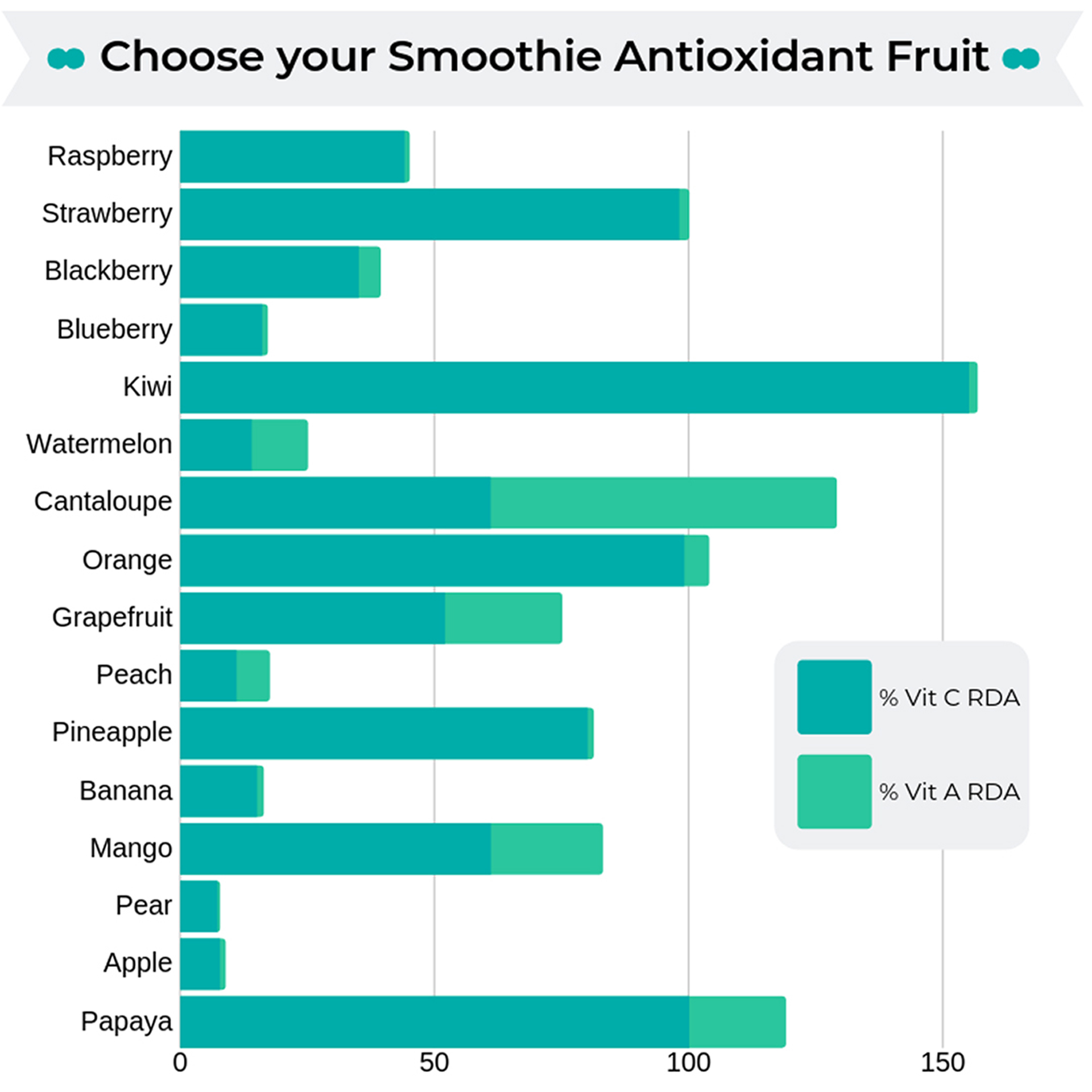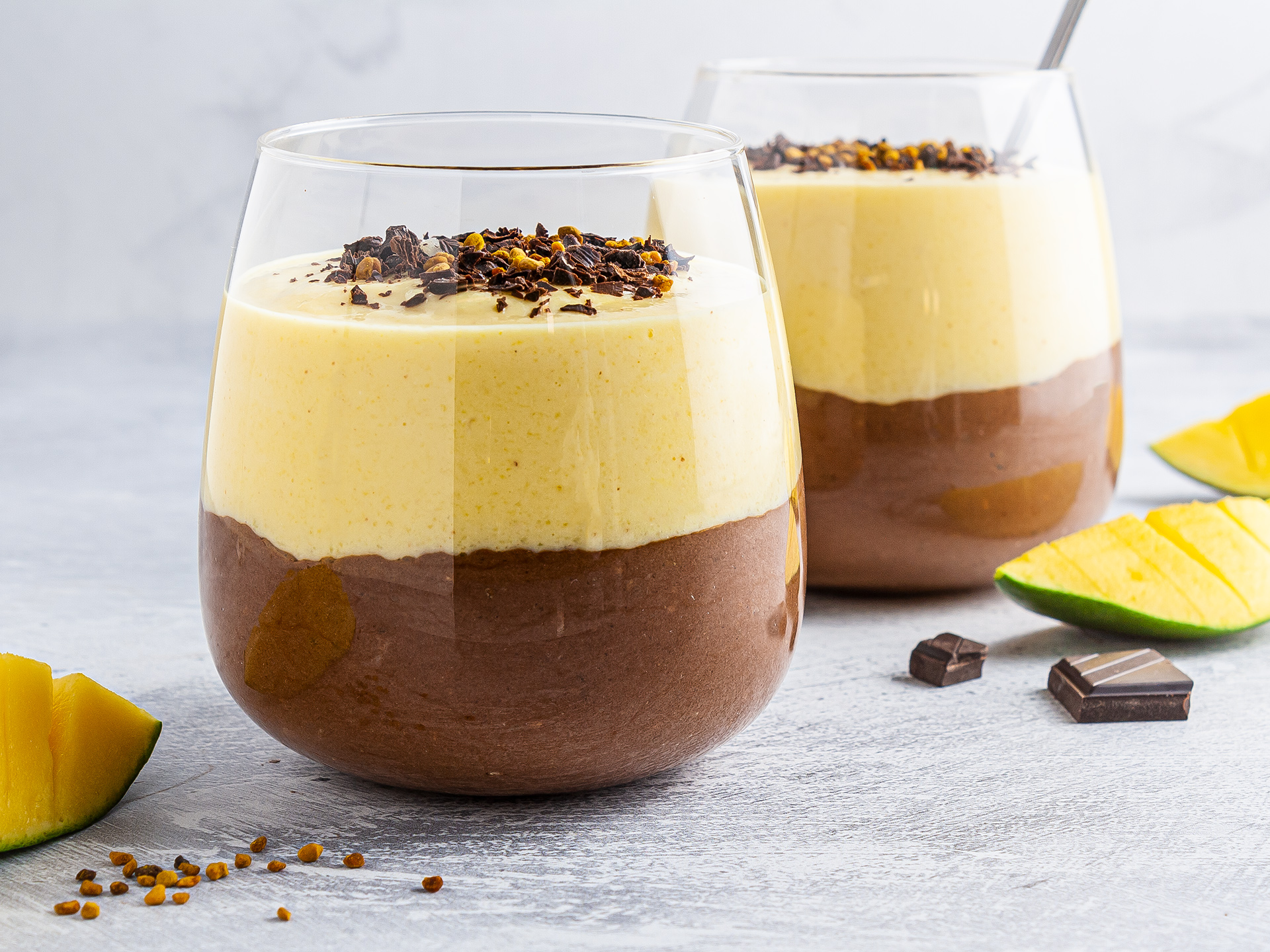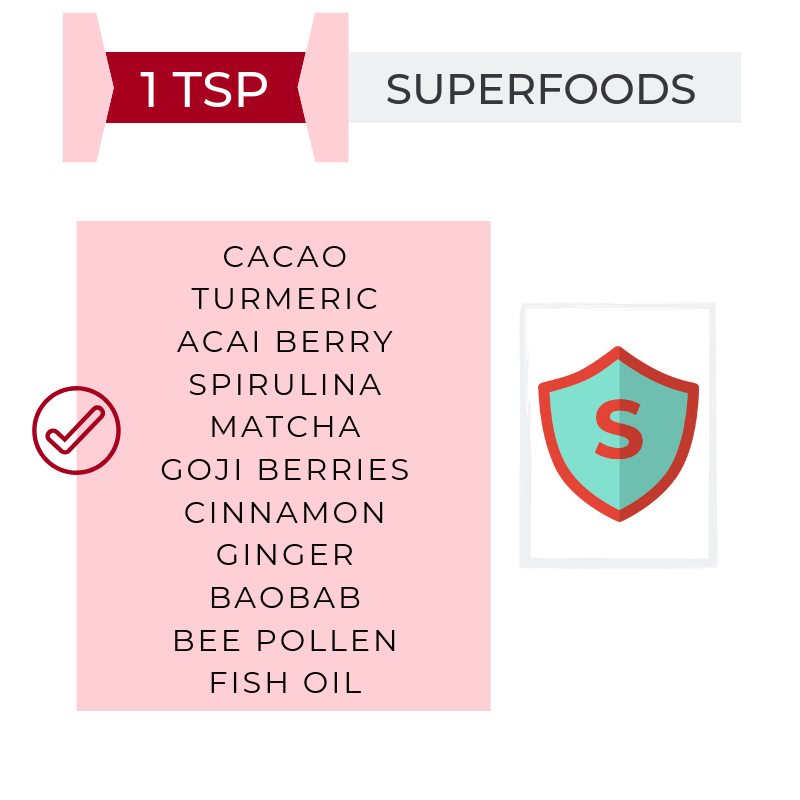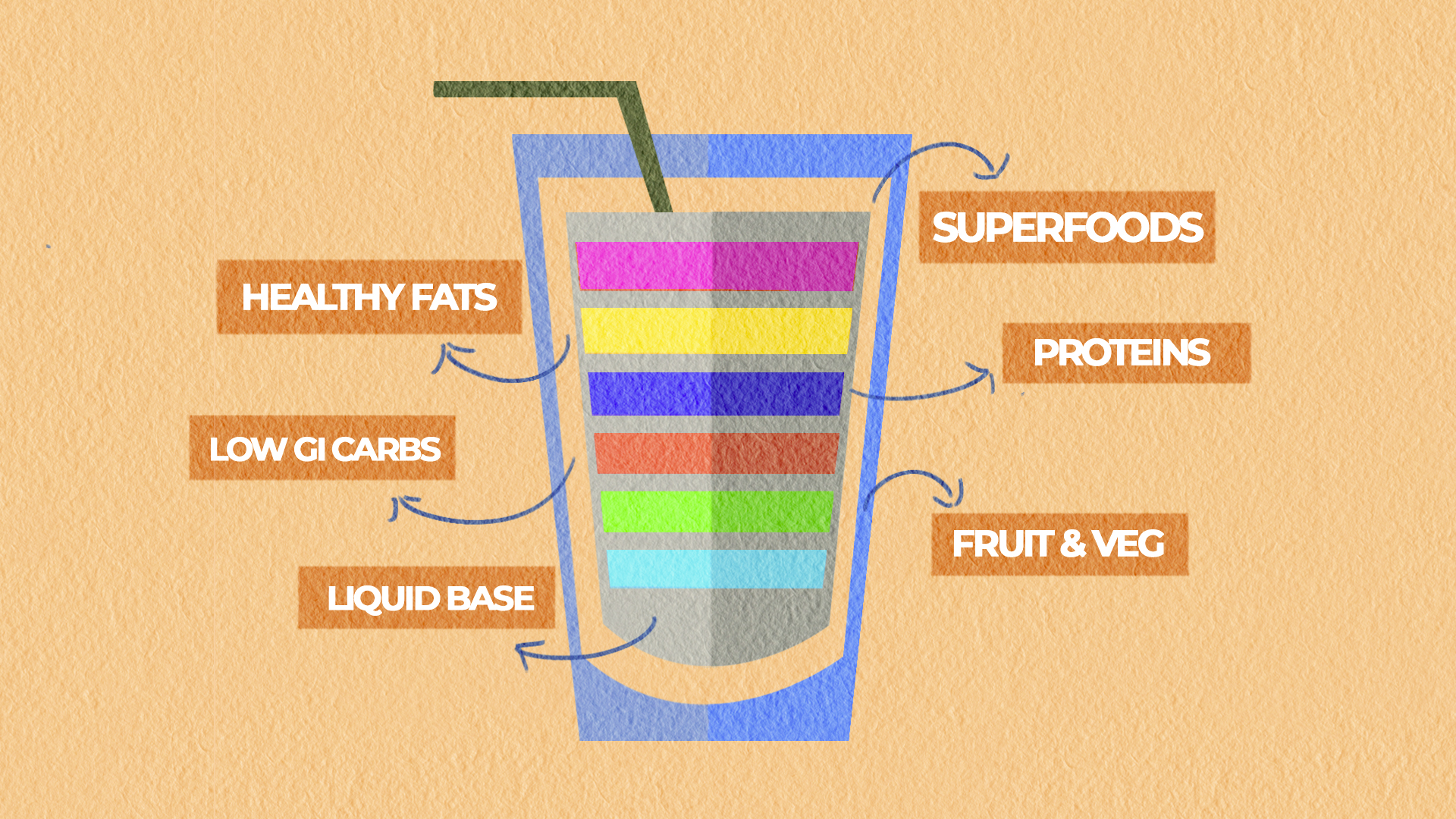Smoothies are such a quick and easy way to prepare a healthy breakfast or post-workout snack to enjoy at home or on-the-go.
Even if preparing a smoothie is super simple, knowing how to make a balanced one is not that straightforward.
So, we are here to help you with essential tips on how make your next smoothie super nutritious thanks to a balanced combination of healthy fats, proteins, and fibre-rich carbohydrates.
Moreover, we'll see how using certain ingredients over others or adding superfoods to you smoothie can increase your intake of vitamins, minerals and trace elements and boost your overall wellbeing.
Making a balanced smoothie is just like making a healthy meal.
So, when your smoothie is prepared with the right combination of carbohydrates, fats, and proteins and provides a source of essential vitamins and minerals, it can really be considered as a healthy snack or a meal replacement.
A healthy and balanced smoothie recipe should have the following components:
Liquid Base
Fibre-rich Carbohydrates
Fruits
Vegetables
Low GI Carbohydrates Boosters
Lean Proteins
Healthy Fats
Health Boosters
1. Liquid Base
First thing when preparing your smoothie is to choose the liquid base. Different ingredients affect the texture and consistency of the drink but also its flavour and nutritional profile.
By changing the amount used you can make the smoothie runnier or thicker according to taste.
Water & Brewed Tea
Choose water or brewed tea if you prefer keeping the calories intake low or if you don’t want to affect the overall taste of your smoothie.
By adding brewed tea like green tea or white tea in your smoothie you can benefit from the detoxifying properties of these plants and also boost your metabolism.
Coconut Water
Coconut water is a classic choice in many smoothies as:
It is low in calories, fats, and sugars
Adds a light texture and it’s perfect for tropically flavoured smoothies
Promotes hydration and restores electrolytes after exercise as it’s rich in potassium, calcium, magnesium, and sodium.
Cow Milk
If you want to give more richness and add nutrients to your smoothie you can choose milk as a liquid base. Compared to plant-based milk, cow milk has more fats but also more proteins. Moreover, milk is:
A source of calcium and vitamin D, essential for strong bones and teeth
Contain all the essential amino acids
If possible, prefer semi-skimmed milk to skimmed milk as it is higher in fat soluble vitamins.
Plant-Based Milk
Plant-based milks are a great alternative to cow milk and are suitable for lactose intolerants and vegans.
There are different drinks and they vary in their properties:
Almond Milk
Low in calories, fats and carbs compared to the other milks
Adds a nutty flavour and creaminess
Oat Milk
Higher in carbohydrates but very low in fats
Adds a very creamy and thick texture without affecting the flavour
Soy Milk
Protein content similar to cow milk
Doesn’t affect flavour
In the chart below, you can the different nutrient profile for the liquid base ingredients and make a choice that meets your needs and preferences.

2. High-Fibre Carbohydrates
After choosing the liquid base, it’s time to move onto the bulk of your smoothie, namely the carbohydrates.
A balanced smoothie should have a combination of quality carbohydrates to make you feel satiated for longer reducing the need for snacking during the day.
These include fruit, vegetables, and whole grains as they contain both simple carbohydrates - known as sugars - and complex carbohydrates - which include starches and fibres.
Fruits are higher in sugars and grains are higher in fibres, while vegetables are in between.
A common mistake is to prepare a fruit-only smoothie which leads to an unwanted sugar overload in your meal which is not really healthy.
How Many Carbs
Now that you know which types of carbohydrates to use in your smoothie, it’s important to use the right amount.
As carbohydrates should make up one-third of your food intake and provide from 40% to 60% of the calories in a meal, when preparing your smoothie aim to use:
Fruit
1 serving of fruit
80g or 1 medium-sized fruit, two small fruits or a handful of berries
Vegetables
2 servings of vegetables
80g or 1 salad cup of raw vegetables
Whole Grains
1 serving of whole grains
30g of oat, bran, or muesli

Fruits
With fruit, really anything would do for a smoothie.
You can pick your favourite fruit and experiment with tasty combinations, but we also recommend you go with what’s in season as it will taste better and be more nutritious (and cheaper!).
To make it easier for you to choose here is a list of fruits according to their main properties, such as sugar content, fibres and vitamins.
Low sugar fruits
If you are following a low-sugar diet, then the following fruits are excellent choices to keep your blood sugar levels smooth:
Raspberries, strawberries, blackberries, and blueberries
Kiwi
Watermelon and cantaloupe
Citrus fruits like orange, lemon, and grapefruit
Peach
Pineapple
High-fibre fruits
If you want to prepare a balanced smoothie that increases satiety and prevents constipation then choose the following high-fibre fruits:
Apples and Pears
Bananas
Raspberries and Blackberries
Oranges
Strawberries

High Vitamin C fruit
Vitamin C, or ascorbic acid, is a powerful antioxidant that helps to fight and resist infection.
So choose the following vitamin C-rich fruits if you are feeling weak and want to boost your immune system:
Citrus fruit like orange, lemon, and grapefruit
Kiwi
Strawberries and blackcurrant
Cantaloupe

High Vitamin A fruit
If you want to support your eye health and maintain healthy skin and hair choose deep yellow fruits as they are rich in antioxidant vitamin A.
Cantaloupe
Mango and papaya
Grapefruit
Peach and apricot

Vegetables
Vegetables are a very low-calorie ingredient to add to weight loss smoothies and they contain fewer sugars than fruits. Also, they are rich in fibre, vitamins, minerals and trace elements.
Unlike fruits though, not all vegetables are suitable for a smoothie as some blenders cannot process very hard vegetables. Also, some veggies don’t taste as good when eaten raw or they might affect the flavour of your smoothie.
Here is a list of the best vegetables and herbs to use in your smoothie blend:
Carrots
Cucumber and Celery
Kale and Spinach
Beetroot
Watercress
Mint, Basil, Parsley
Sprouts
Collards and Swiss chards
Zucchini
Green cabbage
Low GI Carbs Boosters
Add a portion of whole grains to the smoothie blend to balance your carbohydrates intake, for example, when you are preparing one as a meal replacement.
The extra carbs will make you feel satiated for longer without the need to snack during the day.
Also, if you want to have your smoothie as a post-workout snack, added carbs will help during the recovery. Here, aim for a carb to protein ratio of 3:1 - for example 30g of carbs and 10g of proteins.
Whole wheat and oats are great carbs choices as they have a low glycemic index (GI) and provide many health benefits thanks to their high-fibre content.

Rolled Oat
Oat is a great choice if you are looking for a gluten-free grain. It’s easy to find at the supermarket, but make sure you choose old-fashioned rolled oat as the instant one is heavily processed and causes a quick spike of sugars.
A 30g serving of oat provides 12% of the RDA of dietary fibres which include beta-glucan, a soluble fibre which help to reduce cholesterol and control blood sugar levels.
Sugar-free Muesli
Muesli is a mix of toasted whole oats and wheat flakes with added nuts, such as almond and hazelnuts, and dried fruit like raisins.
Make sure you choose sugar-free brands and keep in mind there is a higher content of sugars compared to that found in plain oat or bran because of the added dried fruit.
However, using a serving of 30g of muesli add a rich flavour to your smoothie thanks to nuts and dried fruit which also provide important minerals and trace elements.
Bran
Bran is the outer layer of whole cereals and although there are many varieties, oat bran and wheat bran are the easiest to find.
Add one or two tablespoons of bran to your smoothie blend if you want to give a real fibre boost to your drink.
Bran provides B vitamins which help your body to get more energy from the food you eat and it’s also a source of iron with 17% of your RDA in one 30g serving.
3. Lean Proteins
Adding a source of protein to your smoothie is a real game changer in making a balanced smoothie recipe.
They help you to feel satiated and also support the immune system and metabolism and maintain muscles.

It’s important that you choose a healthy source of proteins, like low-fat dairy products and soy products. Also, you can easily add protein powders to your smoothie.
How many proteins you should have per meal depends on your weight, but on average one should aim to 15g of proteins, while for those practicing intense physical activity the target can be up to 30g per meal.

To help you choose the protein source to add to your smoothie, here is a useful list:
Yogurt
Yogurt is packed with probiotic and healthy bacteria that boost your immune system and keep a healthy digestive system.
It also adds a great texture and consistency to the smoothie.
We recommend using a serving of one 150g pot and you can choose between:
Greek Yogurt
Provides 10 grams of proteins in 100g.
It’s a source of calcium, potassium, iodine, and vitamin B12.
Soy Yogurt
Plant-based alternative for vegans or lactose intolerants and source of omega-3
Provides 5 g of proteins in 100g.
Cottage Cheese
Cottage cheese provides 12g of proteins per serving and a serving consists of 200g.
Like other dairy products, it’s a source of B vitamins, calcium, phosphorous, and selenium.
It also adds rich and dense texture, perfect if you are using fruit and vegetables with high water content.
Protein Powder
You can add protein powder as a supplement to your smoothie to reach your daily target of proteins or you can use it on its own.
Good examples of protein powders are:
Brown Rice Protein
Hemp Protein
Soy Protein
Pea Protein
Whey Proteins
When preparing your balanced smoothie, add 2 tablespoons of whey, soy or hemp protein powder or 3-4 tablespoons of vegetarian protein powder, like pea and rice proteins, to reach 15g of proteins per serving.
Other Sources
Keep in mind that other ingredients in your smoothie mix might contain proteins too. For example, the milk in the liquid base or the fat sources - that we’ll see in the chapter - like seeds and nuts.
As a piece of advice, avoid getting over 30 g of proteins per serving and try to balance the ingredients in your smoothie formula to get the desired amount of proteins.
4. Healthy Fats
You may want to skip adding fats to your smoothie thinking you’ll get a healthier snack. However, when consumed in moderation, fats are great for you.
In fact, fats deliver essential vitamins to our system, act a reserve of energy, and help the metabolic processes.
When it comes to choosing fats, you should opt for those low in saturated fats, like the avocado, nuts, and seeds.
To prepare a balanced smoothie, we recommend you aim for 10g of fats per serving.
Avocado
Unlike other fruits, it’s low in carbs and high in healthy fats and provides many vitamins including C, E, and B group.
Use 1/3 or half of avocado per serving to get the recommended amount of healthy fats.
Nuts & Nut Butter
Add a handful of nuts (about 25g or 1 oz) or 1-2 tablespoons of nut butter to boost your smoothie with healthy unsaturated fats like omega-3 and omega-6 which help to regulate cholesterol levels. They also provide fibres, vitamin E and proteins.
Good choices include:
Almonds, high in vitamin E
Walnuts, high in magnesium and omega-3
Cashews, high in magnesium
Brazil nuts, a source of selenium
Hazelnuts, high in vitamin E and magnesium
If you prefer, you can soak the nuts in water before adding them to the blender.
Seeds
Seeds have many important nutrients including healthy fats, fibres, and vitamins.
There are many seeds you can choose from:
Soaked Chia Seeds, also high in fibres
Hemp Seeds, also high in proteins
Ground Flaxseeds, the best source of omega-3 fatty acids
Pumpkin Seeds, a great source of omega-6 fatty acids
Sesame Seeds, also high in iron and calcium
Add a handful (about 25g or 1 oz) or 1-2 tablespoons of seed butters.

Other Sources
If you have included dairy products in your smoothie blend, like yogurt and milk, you already have a source of fats and you can use the above ingredients just to top up your intake of healthy fats.
Compared to plant-based alternatives, dairy products are higher in saturated fats, so make sure you choose low-fat versions.
5. Health Boosters
Now that you've learnt how to make a balanced smoothie, it's time to take your smoothie to the next level! You can do so by adding health boosters, namely those ingredients which are effective in promoting wellbeing.

We recommend using 1 to 2 teaspoons per serving and you can add as many superfoods as you like.
To help you choose the best boosters in your balanced smoothie here is a useful list:
Cacao Powder or Cacao Nibs: to naturally improve your mood and get antioxidants
Vanilla: to add a sweet aroma to your smoothie
Cinnamon: for a pungent aroma and to help controlling blood sugar levels
Turmeric: a potent anti-inflammatory and antioxidant (remember to add black pepper to enhance its effects) that gives a beautiful yellow colour to your smoothie
Ginger: for a zesty and biting flavour and to aid digestion
Matcha: for a bright green colour and to boost your metabolism and memory
Bee Pollen: to give a floral taste and boost your immune system
Acai Berry: for a purple colour and source of vitamin C and antioxidants
Baobab Powder: for a boost of nutrients and to improve digestive health
Spirulina: this deep blue-green alga helps to control cholesterol and gives a rich green colour
Goji Berries: deliciously sweet and rich in vitamin A and C and other benefits
Fish Oil: to supplement your intake of omega-3 fatty acids

6. To Satisfy Your Sweet Tooth
Even if your smoothie is already balanced in its sugar content thanks to the fruit, we know there are days when you are really craving a sweeter treat.
One solution is to use very ripe fruit as it has a higher sugar content or you could opt for a natural sweetener.
Compared to white confectioner sugar, the following alternatives have:
Maple Syrup: almost half of the sugars and provides many antioxidants
Agave Nectar: almost half of the sugars and a low GI
Raw Honey: a similar content of sugars but it is rich in minerals and vitamins
Stevia: no calories and sugars
Xylitol: it doesn’t spike blood sugars and insulin
Dates: have almost half of the sugar and they provide fibres
Always use sweeteners in moderation to control blood sugars and keep a healthy weight.
To Sum Up
We hope that you have learned more about how to make your smoothie more balanced and healthy by choosing the right ingredients in the right amount.
Here are some of our delicious balanced smoothie recipes:
Thanks for reading, now it’s time to get your blender ready!
Have fun!


